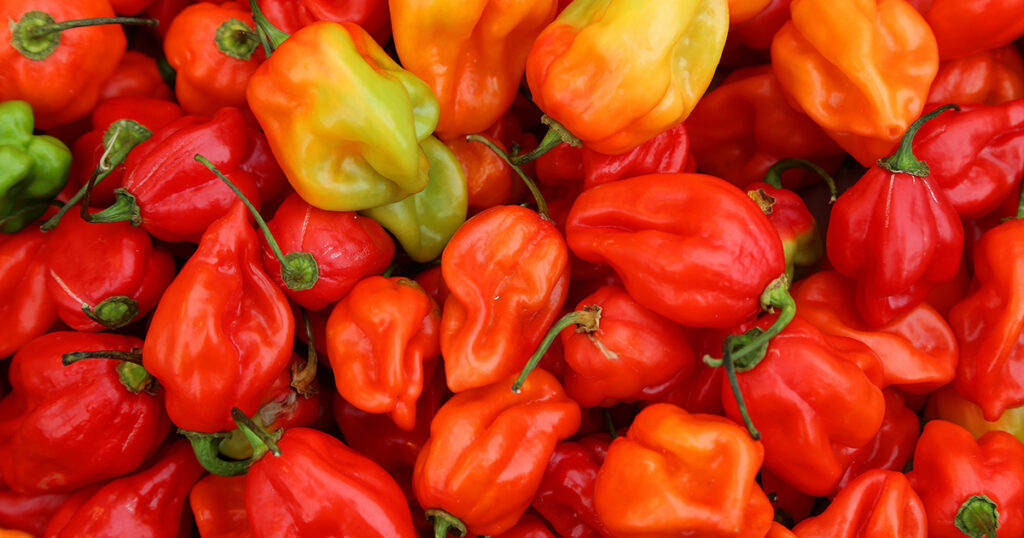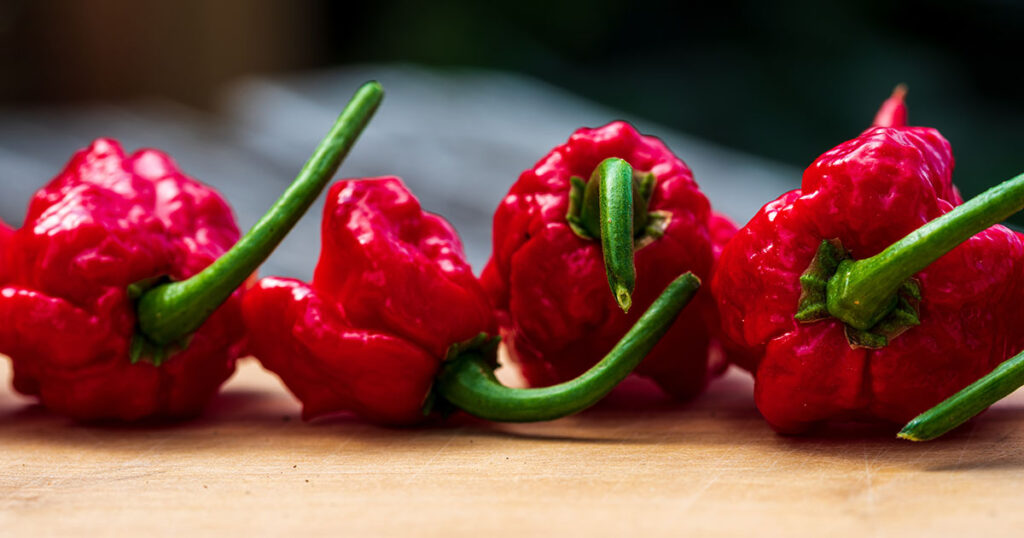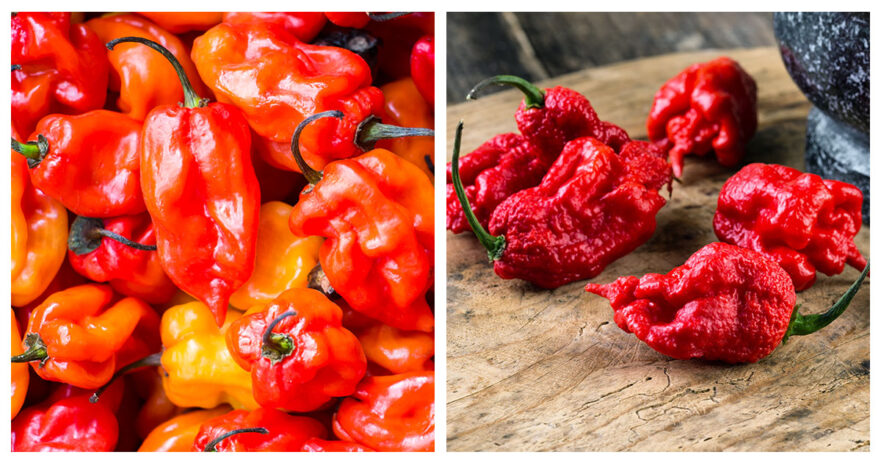Two contenders stand tall in heat and flavor: the Habanero and Carolina Reaper. These two chili varieties have won the hearts and palates of spice enthusiasts worldwide. Yet, each brings unique attributes. Join us as we delve into the captivating world of these two peppers, exploring their distinct heat levels, flavors, and culinary uses. The journey promises to be both enlightening and, dare we say, spicy.
| Habanero pepper | Carolina reaper pepper | |
| SHU | 100,000 - 350,000 | 1,400,000 - 2,200,000 |
| Median SHU | 225,000 | 1,800,000 |
| Flavor | Fruity and floral, sweet with a significant heat | Fruity and sweet, with an intense and lasting heat |
| Species | Capsicum chinense | Capsicum chinense, Hybrid (Naga pepper x Habanero) |
| Origin | Peru, today biggest producer is Yucatan Peninsula, Mexico | South Carolina, USA |
| Uses | Salsas, hot sauces, jerk seasoning, marinades, etc. | Hot sauces, salsas, chili, marinades, etc. |
Table of contents
What is a Habanero Pepper?

Hailing from the Amazon region and widely adopted in Mexican and Caribbean cuisines, the Habanero pepper stands out with its fiery personality and fruity essence. This compact, lantern-shaped pepper showcases vibrant colors as it ripens, transitioning from green to fiery red, sunny orange, and brown.
Unassuming in size but not heat, the Habanero lands a solid punch on the Scoville scale, boasting a rating from 100,000 to 350,000 SHU. But it’s not all about the heat. Habaneros are also celebrated for their fruity, tangy flavor, bearing floral notes that add depth to their heat.
The Habanero pepper’s unique combination of taste and heat has made it versatile in the kitchen. It shines in various dishes, including salsas, hot sauces, and daring spicy desserts.
The Habanero is not confined to the culinary world; it also makes for a vibrant addition to your home garden. With adequate sunlight and care, these peppers are quite the growers and will reward you with a colorful and spicy harvest.
What is Carolina Reaper Pepper?

The Carolina Reaper, a fiery creation of pepper cultivator Ed Currie, stands as the world’s hottest pepper, a title certified by the Guinness World Records. This fearsome chili originates from the soils of South Carolina, earning its infamous reputation with an astounding Scoville rating of 1,400,000 to 2,200,000 SHU. This heat level surpasses most other peppers, leaving them in Carolina Reaper‘s fiery wake.
However, this spicy dynamo is more than just a one-trick pony. Behind the Carolina Reaper’s formidable heat lies a surprisingly fruity, sweet flavor that adds complexity to its profile. Unexpected hints of cinnamon and chocolate tease the palate, transforming the Reaper from a scorching chili into a culinary experience.
Cultivating Carolina Reapers at home might seem like a daredevil’s task, but it’s an adventure that promises exhilarating rewards for those who crave extreme heat. With patience, care, and tolerance for Scoville-induced tears, you can nurture a crop of these record-breaking peppers.
What similarities are there between Habaneros and Carolina Reaper peppers?
Despite their striking differences in heat intensity, Habaneros and Carolina Reapers share several similarities.
Both peppers hail from the Capsicum chinense family and favor warm, sun-drenched climates with well-draining soil. These similarities make them suitable contenders for heat-loving gardeners seeking a rewarding challenge.
Flavor-wise, both Habaneros and Carolina Reapers surprise with a distinct fruity undertone. Amid their capsaicin-induced blaze, they deliver an unexpected sweetness, creating a complex and tantalizingly balanced flavor profile.
This sweetness softens their fiery blow, rendering them more than tear-inducing spice generators. Their flavors contribute depth and richness, elevating dishes from ordinary to extraordinary.
Habaneros and Carolina Reapers are culinary chameleons. Despite their intense heat, they have their place in various dishes. From turning up the heat in salsas and hot sauces to lending an unforgettable kick to main dishes, these peppers demonstrate versatility and charm.
What are the differences between Habanero and Carolina Reaper peppers?
While Habanero and Carolina Reaper peppers originate in the same botanical family, they are distinct, and their differences start with their Scoville Heat Unit scores. Habanero ranges from 100,000 to 350,000 SHU as one of the spicier peppers. However, Carolina Reaper smashes all records, delivering a tongue-scorching 1,400,000 to 2,200,000 SHU, making it the officially recognized world’s hottest pepper.
Their flavor profiles also set these peppers apart. Habanero peppers offer a citrusy note with subtle floral undertones and a tantalizing sweet and spicy balance that works well in various dishes. In contrast, Carolina Reaper peppers deliver a sweet flavor, underscored by surprising hints of cinnamon and chocolate, which lend a unique complexity with their intense heat.
These two fiery contenders are also visually distinct. Habaneros are recognized for their small, lantern-like shape and vibrant color, ranging from greens to reds and oranges.
In contrast, Carolina Reapers command attention with their gnarled, sinister appearance, characterized by a pointed, stinger-like tail and deep red hue. This visual difference is a fitting reflection of their heat, with the Carolina Reaper’s menacing appearance warning of the extreme heat it packs.
Which Pepper Should You Choose?
Your choice between a Habanero or Carolina Reaper depends on your heat tolerance and desired flavor.
Habanero’s sweet and fruity flavor is a fantastic choice for Mexican and Caribbean cuisines. Carolina Reaper’s intense heat and sweet-cinnamon-chocolate undertone bring a unique twist to salsas, hot sauces, and marinades.
No matter which pepper you choose, remember that these chilies pack a punch, so handle them with care and use them sparingly!
FAQ about Habanero and Carolina Reaper
What dishes are best suited to Habanero peppers?
Habanero peppers, with their exceptional heat and citrusy flavor, complement a variety of dishes. They are prominent in Mexican and Caribbean recipes, where their spice enhances dishes‘ rich, complex flavors. Whether adding a kick to salsas and marinades, balancing the sweetness in desserts, or creating a bold base for hot sauces, Habaneros provide an exciting and fiery flavor, bringing a new level of zest to any dish.
How can I use Carolina Reaper peppers in cooking?
Carolina Reaper peppers offer extreme heat and intricate flavor, elevating hot sauces, hearty chili concoctions, and rich marinades to new heights. Their distinctive taste, marked by a fruity sweetness and notes of cinnamon and chocolate, provides a complex depth with their formidable heat. However, their extreme spiciness calls for careful usage – a little goes a long way, and judicious use creates unforgettable, fiery culinary experiences.
Are Habanero and Carolina Reaper peppers the same?
Habanero and Carolina Reaper peppers are different. Habaneros, known for their citrusy, floral, and sweet flavor, register from 100,000 to 350,000 SHU on the Scoville scale, representing significant heat. In contrast, Carolina Reapers are the world's hottest pepper, reaching an astonishing 2,200,000 SHU, alongside their distinct sweet flavor. The substantial disparity in heat and taste profiles set these two peppers apart.
Can I substitute Habanero for Carolina Reaper in recipes?
Substituting Habanero for Carolina Reaper in recipes is possible, but remember that these peppers differ considerably in their heat. Carolina Reaper is significantly hotter; therefore, you might need fewer Reapers to match the heat of Habanero. Conversely, using Habanero in place of Carolina Reaper may require more peppers. Ensure to adjust quantities carefully, aiming to achieve the intended heat while preserving the overall balance of the dish. Remember, the goal is enhancing flavor, not only heat.
How can I reduce the heat of Habanero and Carolina Reaper peppers?
Reducing the heat of Habanero and Carolina Reaper peppers involves careful preparation. Most of a pepper's heat resides in its seeds and white pith, known as the placenta, where capsaicin, the chemical responsible for spiciness, is concentrated. Remove these parts before using peppers in your recipes to reduce their heat. However, even after this, both peppers still pack a punch. Always handle these fiery varieties with gloves to protect your skin and avoid accidentally touching your eyes or other sensitive areas.
Can I grow Habanero and Carolina Reaper peppers at home?
Cultivating Habanero and Carolina Reaper peppers at home is achievable with the right conditions. These fiery varieties flourish in sunny spots, preferring well-draining soil to avoid root rot. They require regular watering but take care not to overwater them. Be patient, as they have a longer growing period compared to other varieties. Successful cultivation yields a colorful array of these powerful peppers that elevates your dishes to new levels of spiciness. As a precaution, ensure they're placed out of reach of children and pets due to their high heat.
